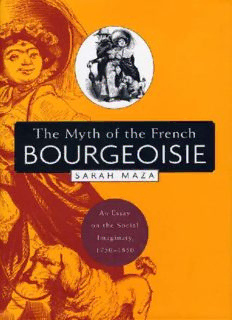
The Myth of the French Bourgeoisie: An Essay on the Social Imaginary, 1750-1850 PDF
Preview The Myth of the French Bourgeoisie: An Essay on the Social Imaginary, 1750-1850
the myth of the french bourgeoisie The Myth of the French Bourgeoisie ¥μ An Essay on the Social Imaginary 1750–1850 SARAH MAZA harvard university press Cambridge,Massachusetts,andLondon,England Copyright©2003bythePresidentandFellowsofHarvardCollege Allrightsreserved PrintedintheUnitedStatesofAmerica FirstHarvardUniversityPresspaperbackedition,2005 LibraryofCongressCataloging-in-PublicationData Maza,SarahC.,1953– ThemythoftheFrenchbourgeoisie:anessayonthe socialimaginary,1750–1850/SarahMaza. p.cm. Includesbibliographicalreferencesandindex. ISBN0-674-01046-9(cloth) ISBN0-674-01769-2(pbk.) 1.Middleclass—France—History—18thcentury. 2.Middleclass—France—History—19thcentury. I.Title. HT690.F8M392003 305.5(cid:2)5(cid:2)0944—dc21 2002031809 ForSeanShesgreenandDeirdreShesgreen, francophilesandgreatwriters 8 contents Acknowledgments ix Introduction:IsThereaClassinThisText? 1 1 TheSocialImaginaryinPrerevolutionaryFrance 14 God-GivenOrder BourgeoisGentlemen RethinkingNobility TheGoodEarth 2 Commerce,Luxury,andFamilyLove 41 Wealth,Circulation,andtheNewWorldofObjects Luxuryand“LesMoeurs” Love,Tears,andSocialFusion 3 RevolutionaryBrotherhoodandtheWar againstAristocracy 69 WhatWastheThirdEstate? PopularViolenceandPropertiedCitizens BrothersinArms DefiningtheEnemy 4 TheSocialWorldafterThermidor 102 ASocialRevolution? IntheWakeoftheTerror contents viii HistoricalChangeandtheNewAristocracy HonorandtheState 5 ThePoliticalBirthoftheBourgeoisie, 1815–1830 131 IndustrywithoutBourgeoisie ThePoliticsofthePresent ThePoliticsofthePast PoliticsandClass 6 TheFailureof“BourgeoisMonarchy” 161 HowBourgeoiswastheBourgeoisMonarchy? TheDangerousMiddleGround AntibourgeoisUniversalism Balzac’sWorld Conclusion:TheBourgeois,theJew,andtheAmerican 193 Notes 207 Index 245 8 acknowledgments Writing this book was made possible by abundant institutional, intel- lectual, and personal support at every stage. I began reading and thinking about the bourgeoisie while a fellow at the Woodrow Wilson CenterinWashington,D.C.,andIamgratefultotheCenter’sdirector, thelateCharlesBlitzer,hisstaff,andtheotherfellowsformakingthat year so productive. I continued to work on the book thanks to fellow- ships from the John Simon Guggenheim Foundation and Northwest- ern University’s Alice Berline Kaplan Center for the Humanities. I thanktheKaplanCenter’sdirector,HelmutMuller-Sievers,andassoci- ate director, Elzbieta Foeller-Pituch, for seeing me through the home stretch. I am indebted to the staffs of the Library of Congress, Regenstein Library, and Northwestern University Library, and very gratefulfortheexpertassistanceIgotfromthreeskilledresearchassis- tants, Molly Laird, Sean Field, and William Slauter. Joyce Seltzer of Harvard University Press took an interest in this project from the be- ginning, and I thank her for her confidence and astute advice throughouttheprocess.AnitaSafraneditedthemanuscriptwithgreat careandconsummateskill. Because this book’s subject is so broad-ranging, and because I was fortunatetopresentmyideastomanygroups,Ireceivedcountlesssug- gestions,rangingfromcommentsbylong-timefriendsandcolleagues inmyfieldtothosebyunknownaudiencemembersattalks.Sincemy thesis is counterintuitive and somewhat controversial, reactions to my presentationsranthegamutfromenthusiasticagreementtocomplete
Description: